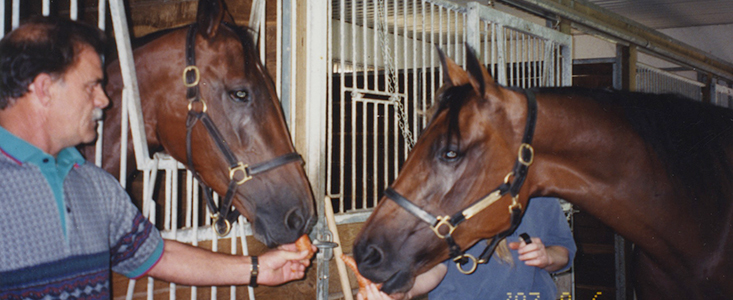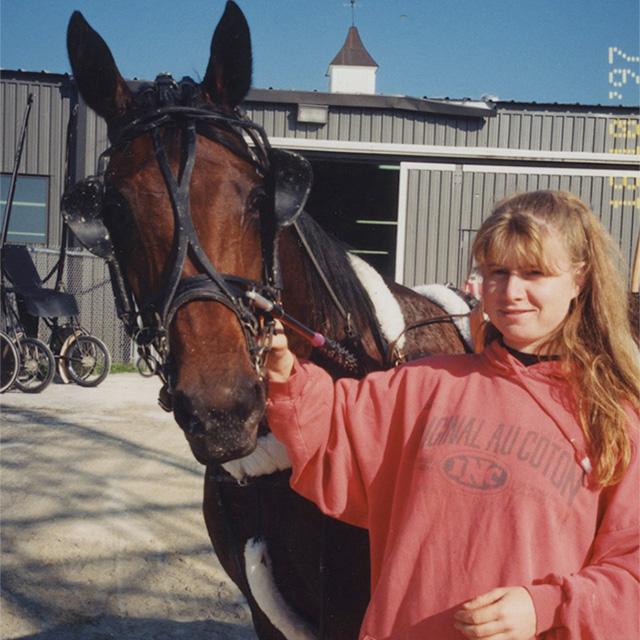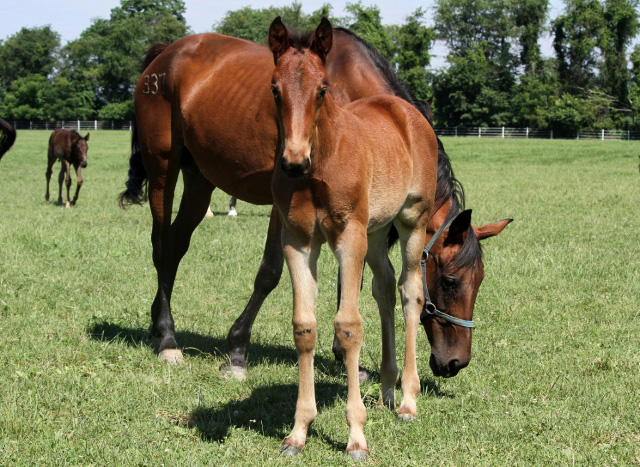Million-Dollar Mama

A star in Quebec at age two and three, the daughter of Rumpus Hanover eventually had to move to Ontario to find worthy competition. Early in her five-year-old year she found herself with a new trainer (Rick Zeron) and a new caretaker (Linda Bedard)... two other Ontario residents that were transplanted natives of Quebec. Now a retired broodmare after a successful breeding career with Hanover Shoe Farms, read the story of how “Tooshie” was able to reach millionaire status with a dramatic win in the final start of her illustrious on-track career. By Melissa Keith

It’s not easy to make it into the Canadian Horse Racing Hall of Fame, nor should it be. A million dollars in career earnings isn’t enough to warrant recognition, particularly over a span of seven years and 142 races. But what of the path to that million? Was it so different, back in 1998?
Then, as now, pacing mares usually race for smaller purses than their male counterparts. Depending on where they are racing, the best young distaff pacers may even find themselves pitted against the most seasoned mares, or even males. Some, like Tricky Tooshie, outrace the local competition and eventually must relocate. That’s how the Rumpus Hanover-Sangria Belle daughter ended up at Canada’s top harness tracks in 1994, racing for her original trainer, Jean-Louis Deblois.
Linda Bedard, Registrar and Manager of Member Services at Standardbred Canada, described Tricky Tooshie’s exit from Quebec: “When they left, it was a bad time there - everything was closing, they were on strike. Even her three-year-old season, Blue Bonnets was on strike and all the big races were at [Hippodrome du] Quebec that year.”
Tricky Tooshie still holds the oldest record at the defunct Quebec City track: Her 1:56 standard for sophomore filly pacers was set September 5, 1993, in a gate-to-wire Quebec Sires Stakes blowout. A second faster than the place finisher that day, it marked the 11th consecutive win for Tricky Tooshie and regular pilot Sylvain Filion. She then tested the waters of Ontario late in her sophomore season. Her win streak was finally halted at 15, in the Filly and Mare Open at Mohawk Racetrack November 7, 1993.
It had been a remarkable run.
In 1994, Tricky Tooshie’s owner/breeder Laurent Bergevin and trainer/breeder Deblois opted to open their homebred’s four-year-old season with a couple of late summer qualifiers in Montreal. “At the end of her three-year-old year, she was getting a problem in her knees,” explained Bedard. “She had surgery at the end of [that year].” In spite of her issues, Tricky Tooshie came back strong at four, winning both qualifiers and her first pari-mutuel start, all at Blue Bonnets.
November 14, 1994 stands out in Bedard’s memories of the great racemare. “Sheldons Fella actually beat her - I looked after him for Rick [Zeron] that day! It was the last time she raced in Quebec. She raced tough that day.”
Bedard would soon get to know Tricky Tooshie closely - but not right yet. The mare’s next start was in a Filly and Mare Open Handicap at Mohawk, where she was outdueled in the stretch by the great Immortality, and finished 2nd. After 17 more starts on the WEG Circuit, when trainer Deblois returned to Quebec in the spring of 1995, Tricky Tooshie did not.
“She’s the only horse [Deblois] had who could race here,” recalled Bedard, who was working as an Assistant Trainer in the Rick Zeron Stable, based out of Mohawk. “He trained her at two and three-years-old, but then when she turned four, he was going back to Quebec, and he left her with us. So Rick [Zeron] was training her and I was her caretaker.” While Tricky Tooshie did not change ownership, almost everything else in her environment changed dramatically. “That was tough,” admitted her caretaker. “She was from the Quebec Sires Stakes, Quebec racing, but she was determined. It was a big jump.”
The mare’s relationship with her new caretaker also began with a leap of faith, on Bedard’s part. “She was awful! After Jean-Louis dropped her off, she wouldn’t let anybody in the stall, so I had to go in with the wheelbarrow [to get near her and catch her].” Fortunately for Tricky Tooshie’s connections, she loved to race. However temperamental in the barn, she was a complete professional in the paddock and on the track.

“She was not a ‘people person’!” laughed the mare’s former caretaker. “She was my horse. She would follow me everywhere. I could sit in her stall.” Tricky Tooshie delivered top-three finishes in 22 of her 33 seasonal starts at Woodbine and Mohawk as a five-year-old, first winning the Woodbine Filly and Mare Open with her new trainer/driver on June 30, 1995. The 1:52.1s mile would remain her lifetime-best mark, and that ‘95 season would see her compile a tidy $183,400 in earnings.
When she didn’t get the trip she wanted in a race, “Tooshie” let the humans around her know. “A few times Rick would put her at the back, or if she got locked in, she would get mad. She would try to bite people after the race,” said Bedard. On a winning night, “she was always proud of herself,” but still a handful: “People in the test barn were always, ‘Ohhhh, there’s “Tooshie” again!’ She was difficult in that way. In her stall, she would squeal and stuff. On the track [jogging], she would try to kick once in a while.”
Tricky Tooshie continued on at the Fillies and Mares Preferred level for the rest of 1995, and picked up where she left off in 1996, a gritty performer in the distaff pacing ranks at Woodbine/Mohawk. “I was out there every day,” remembered Bedard, “From doing her stall, to jogging her, to doing her bandages. Rick knew she was my girl and he understood that.” The six-year-old mare’s knees and feet had always been her literal sore points, so her caretaker paid special attention to them: “She was in the tub every day, in cold water. She would go in these big boots that went over her knees. It was like a little spa with bubbles, every day. We would poultice her knees and hooves after she raced.”
The 2019 Hall of Fame inductee would earn another $171,430 at age six, racing at the top level on Canada’s toughest circuit. On June 18, 1996, Tricky Tooshie delivered what Bedard considered the mare’s best-ever performance: “The highlight for me was at the end of Ellamony’s career, when [Tricky Tooshie] beat her. There’s not many mares who beat Ellamony.” (The 1995 Canadian Horse Of The Year who entered the Hall of Fame in 1998).
It turned out that Bedard was not the only one who felt the same way, watching the medium-sized Quebec-bred take on her Amazonian rival at Woodbine. “Ellamony was always the best, but ‘Tooshie’ was coming on the outside,” remembered Bedard. “People around me on the backstretch were cheering for her!” Fifth on the outside at the ¾ pole, Rumpus Hanover’s best offspring systematically closed in on the leader, winning by a head in 1:53.3.
The Zeron trainee was taking on the best in the country on a regular basis, many of whom were O’Brien champions as older pacing mares. “Oohs N Aahs [1997 O’Brien winner]; Classy River Gal was a tough one that [Joe] Stutzman had; Miatross; Ellamony [1994 and 1995 O’Brien winner]; Shes A Great Lady [1996 O’Brien winner]; Queens Arms - those mares were tough!” noted Bedard. Jays Table - the first mare to break the 1:50 barrier, and 1998 O’Brien Older Pacing Mare of the Year - was also added to the mix in 1996. In October of 1996, Tricky Tooshie would capture the biggest cheque of her aged career when she finished second to the aptly-named Shes A Great Lady in the $150,000 Milton Stakes at Mohawk.
By the summer of 1997 the dedicated caretaker officially took over the mare’s training. “I had my training license for a long time,” explained the Quebec native. “I worked for Rick, then I needed something different. I had problems with my health. He had a girl looking after her and [Tricky Tooshie] didn’t respond very well. The owner asked if I could take her because they could tell she was not the same. She would stop eating.”
Without an O’Brien Award to draw attention to Tricky Tooshie’s amazing career, the mare’s connections focused on another milestone: hitting the million-dollar mark. Tie-back surgery was recommended when respiratory trouble threatened to derail her seven-year-old season. “When she had to go through the tunnel at Woodbine you could hear her breathing. [The owners] were wondering, ‘Do we do the surgery or send her as a broodmare?’”, recalled her new trainer. Tricky Tooshie had the surgery and “came back like a trooper.” Fifth in her debut for Bedard, the mare won an October 25 qualifier by eight open lengths. On Boxing Day 1997, a lightly-regarded “Tooshie” lit up the Woodbine tote board with a Fillies and Mares Open victory for Chris Christoforou at odds of 24/1.
In 1998, the million-dollar mark was tantalizingly within reach. But Tricky Tooshie’s persistent soreness issues were also flaring up, making Bedard’s job that much harder. “It was work to keep her sound. Her second-last start, we had to scratch. I took her out of the box because she was too sore to race. She spent time in the stall. I wanted her to get there [the $1 million in purse winnings], but I did not want to hurt her, either. When I jogged her on the Monday morning, she wasn’t bad.” Then came a badly-timed quarter crack. It looked like it might mean another scratch for the ultra-game mare, leaving her just shy of attaining seven-figure career earnings.

On March 20, 1998, Bedard’s trainee took to the track at Woodbine; her connections hoped the race would be a career-concluding victory lap, although she was not the betting favourite. “The last start that she raced, I wanted Rick [Zeron] to be driving her. So he agreed,” said the mare’s fifth, and final, trainer. There would be no rivalry between them in Tricky Tooshie’s attempt to go over the magical million.
By the half, it was over. Tricky Tooshie and Zeron took the lead and never surrendered, crossing the finish alone in 1:54.2. The Rumpus Hanover daughter of a Tijuana Taxi dam had become the first Canadian-sired female millionaire, rewarding her backers and believers. The “really nice-looking, blocky” pacer possessed an edge not visible except in the heat of competition, said Bedard: Other, larger mares “might have the speed, but they just don’t have the will.”
And that is what makes greatness in a racehorse: The will - the memorable sense of focus that landed Tricky Tooshie on the Hall of Fame ballot not once, but three times (2016, 2017, 2019). As her on-track competition learned over the years, “Tooshie” had a tendency to stick around for the win. From 142 starts lifetime, she was in the top three 97 times. “She raced some big mares back then,” noted Bedard. “Now I know a million dollars is not that much, but back then, she had to work for it. She was the first Canadian-sired mare to reach a million. That’s pretty big.”
Bedard remembered her last farewell with the new millionaire. “Even the day that I left her in Montreal, she looked at me... I went back to see her about six months later. [The broodmares] were all in the infield of the owner’s training track. I called her - ‘Mommy!’ - and they were quite far away, but she started walking to me.”

Purchased by Hanover Shoe Farms in 1999, Tricky Tooshie has produced progeny with earnings of more than $3.1 million. Her richest is True North Hanover ($732,912), while her fastest is Major Uptrend (1:49f). She gave birth to her 13th and last foal, Techino Hanover, in 2015, and is now pensioned at the legendary Pennsylvania farm. Bedard hopes to finally visit her this summer.
What if the Quebec racing industry had not taken an ominous turn, just as a precocious filly was gaining a taste for winning? “I’m thinking they probably would have kept her there [in Quebec],” Bedard mused. “And I probably would not have moved here with Rick, if the races would’ve been good [there]. I decided to follow him.”
But in the end, the move to Ontario brought Linda and “Tooshie” together - like it was meant to be. It may have been the long way to a million dollars, but it was paced by a tricky mare with a “tooshie” always primed for the next kick.


